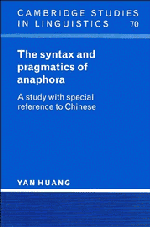Book contents
- Frontmatter
- Contents
- Preface
- Abbreviations used in glosses
- 1 A neo-Gricean pragmatic theory and anaphora
- PART I ANAPHORA IN GOVERNMENT AND BINDING THEORY
- PART II THE PRAGMATICS OF ANAPHORA
- 5 A neo-Gricean pragmatic theory of anaphora
- 6 Further applications of the theory
- 7 Anaphoric production in conversation
- 8 Anaphoric resolution in conversation
- 9 Conclusions
- Notes
- References
- Index of names
- Index of languages
- Index of subjects
8 - Anaphoric resolution in conversation
Published online by Cambridge University Press: 23 October 2009
- Frontmatter
- Contents
- Preface
- Abbreviations used in glosses
- 1 A neo-Gricean pragmatic theory and anaphora
- PART I ANAPHORA IN GOVERNMENT AND BINDING THEORY
- PART II THE PRAGMATICS OF ANAPHORA
- 5 A neo-Gricean pragmatic theory of anaphora
- 6 Further applications of the theory
- 7 Anaphoric production in conversation
- 8 Anaphoric resolution in conversation
- 9 Conclusions
- Notes
- References
- Index of names
- Index of languages
- Index of subjects
Summary
Introduction
In this chapter, I shall turn from a consideration of anaphoric production to an analysis of anaphoric resolution in Chinese conversation. I shall demonstrate that anaphoric resolution in Chinese conversation can largely be accounted for by the interaction of the I- and M-principles. Unlike most previous studies of discourse anaphora, which are based on written narrative, the analysis of anaphoric production in the last chapter and that of anaphoric resolution in this chapter are based on naturally occurring conversation. Although conversation introduces some additional complexities, it also offers some extra means to confirm (or disconfirm) an analysis. Therefore, I shall end this chapter with a brief illustration of how the analysis made here conforms to what the participants in conversation are actually oriented to.
Anaphoric resolution in conversation
There appear to be some precise parallels between intrasentential and discourse anaphora in Chinese: for an antecedent of an anaphoric expression in Chinese conversation, a local subject is preferred to a local object, and a non-split antecedent, to a split one. If none of these NPs seems to be the possible candidate, the next, more remote utterance in the conversation is examined for possibilities in the same order, and so on until the most remote utterance in the conversation is reached. Failure to locate a conversation-internal antecedent leads to an inference to an exophoric or arbitrary interpretation (cf. sections 6.2 and 6.6 of chapter 6).
Let us now look at some illustrations of how anaphoric expressions in Chinese conversation are interpreted by the I- and M-principles. Consider first (8.1).
- Type
- Chapter
- Information
- The Syntax and Pragmatics of AnaphoraA Study with Special Reference to Chinese, pp. 236 - 256Publisher: Cambridge University PressPrint publication year: 1994



